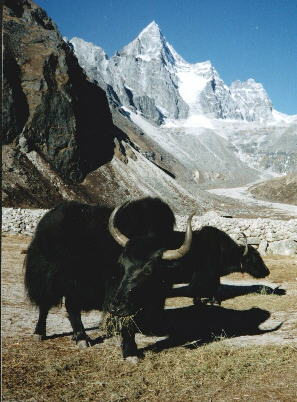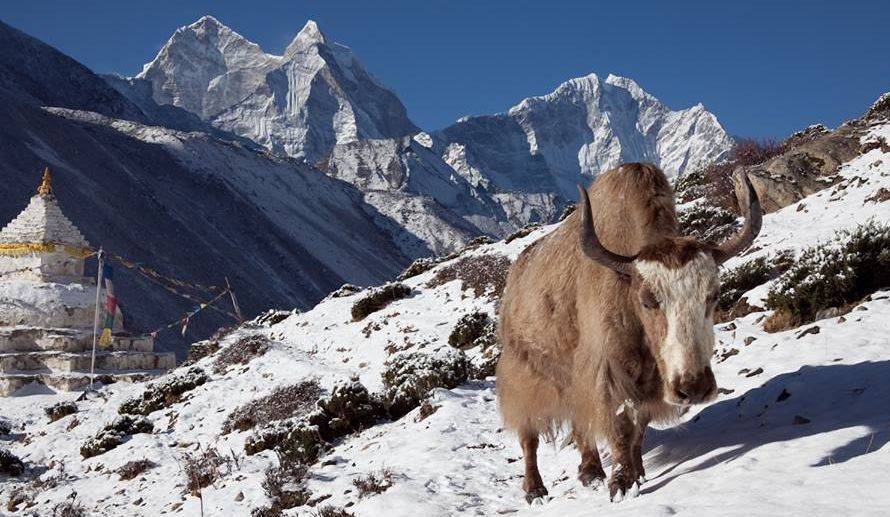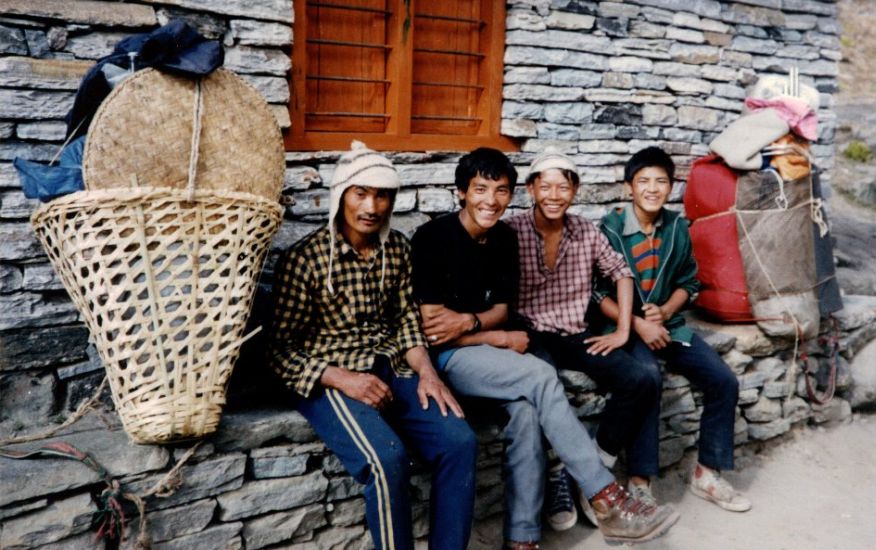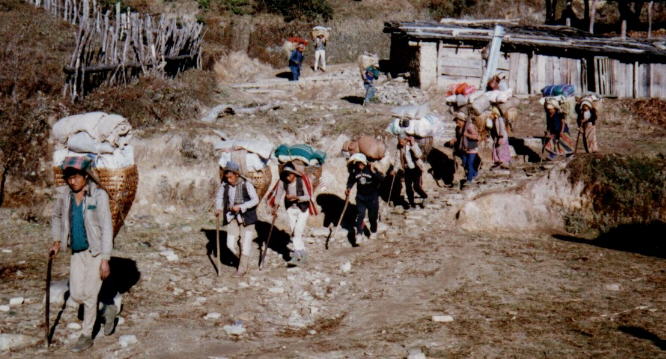

On popular treks in the Nepal Himalaya such as the Annapurna Circuit ( known as the "Coca-Cola Trail" ) and Everest Base Camp ( "the Yak Route" ) you are assailed by a plethora of greetings ranging from the anglo-saxon Good Mornings, G'Days and Hi's through continental Bon Jours, Guten Tags, Grusse Gots and Bon Giornos to the Tashi Daleks of Tibetans and the ubiquitous Namastes of the Nepalese.
Namaste is commonly used as a casual hello or goodbye but can also be bellowed out as a belligerent challenge - in effect " who are you and where do you think you are going? ". In its highest form it is uttered reverentially, with upright hands pressed together, in respect or thanks - " I salute the spirit within thee ".
Do not anticipate thanks however for the customary and very welcome donations of cash or clothing to your trekking staff - it is the giver who is considered the lucky one in having something to give and thereby obtaining merit points to achieve nirvana.
While it is normal practice on narrow paths in the European Alps to give way to uphill traffic this should not be expected in Nepal where most trekkers are not experienced mountaineers. It would also be unwise to attempt to impede a fully laden porter careering down a steep hillside - in Nepal the basic rule of the road is " might is right ". Brashness also counts.

I have however seen porters, complete with their 30Kg dokos, running uphill to escape the sharply pointed horns of a frenzied yak - one of the potentially lethal hazards of trekking in the himalaya. Last autumn in the Solu Khumbu there were two such fatalities - one woman tourist and one Sherpa sirdar heroically trying to protect his group from a train of stampeding yaks.
When you hear the tinkling of their bells you are well advised to get off the track. Should this not be possible ( sheer drop one side, sheer cliff the other ) then holding a hat in front of their eyes is usually sufficient to ward them off. Although normally tractable they should never be treated with contempt - even yak-men exercise considerable caution.

To experience the best from a trek a small group ( 1 to 4 members ) is preferable. Large groups ( more than 8 members ) though more profitable for agencies are less satisfactory in many respects - the greater the number of people then the higher is the probability of problems - logistical, organisational, personality clashes, accidents, health ( many kitchenboys - many hands touching food ).
Managing the day to day expenses of large groups - purchase of fresh vegetables, charges for campsites, wages for porters - can prove too much for the budgeting skillls of some sirdars and the money they are allocated by their agency is exhausted before the end of the trek resulting in a whip round of members. In the remote Makalu region I met a group abandoned by their sirdar who had absconded with the remaining money and their return air-tickets.

With an attendant army of trekking staff and porters large groups are an unwelcome encounter responsible for major hold-ups and frustration on single-file trails and at permit checkpoints. They are the bane of independent,"tea-shop" trekkers who have filled the visitors' logbook in the ACAP ( Annapurna Conservation Area Project ) office in Dhampus on the route to the Annapurna Sanctuary with adverse comments. Diana Penny, the organizer of the biennial Everest Marathon has received complaints about her 40 member groups on their approach march to the race start point at Gorak Shep - the original site of the base camp for climbing expeditions.
Such large groups can completely monopolize lodges and inundate campsites. They are an abomination in wilderness areas. Several times I have been invaded and, overwhelmed by force majeur, de-camped to escape the surrounding bedlam - most people take to the wilds to get away from the madding crowd and are not overjoyed to have it overtake them.

Long trains of professional porters carrying trade goods can also be an impediment to progress when they suddenly stop in mid-path to rest their loads on their T-shaped sticks. I have been tempted to give the end one a good shove to see if they would all tumble like a row of dominoes.
The popular treks of the Nepal Himalaya may be ideal for meeting people from many countries and furthering one's language and social skills but not for seeking silence and solitude. In the peak, post-monsoon season last autumn saturation level was reached in the Gokyo Valley in the Khumbu region when the number of visitors exceeded the capacity of the local lodges.
Of course the great attraction of these routes is the ease of access they provide to the incomparable mountain landscapes of the highest peaks in the world. Considerably fewer trekkers are to be found in the pre-monsoon, spring season or on the more difficult and demanding routes such as the Dhaulagiri Circuit.
Untrampled routes remain in Solu Khumbu as I discovered on my trek to Thare Teng.
( The Commentator, The (Glasgow) HERALD, Saturday 10th April 1999 )
Himalaya Map - Nelles ( UK , USA )
Nepal Trail Map - Nelles ( UK , USA )